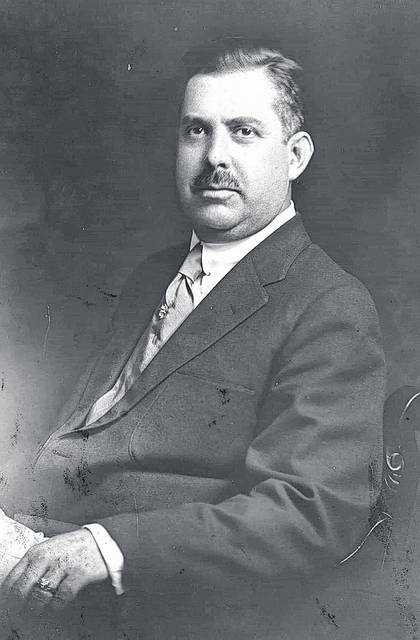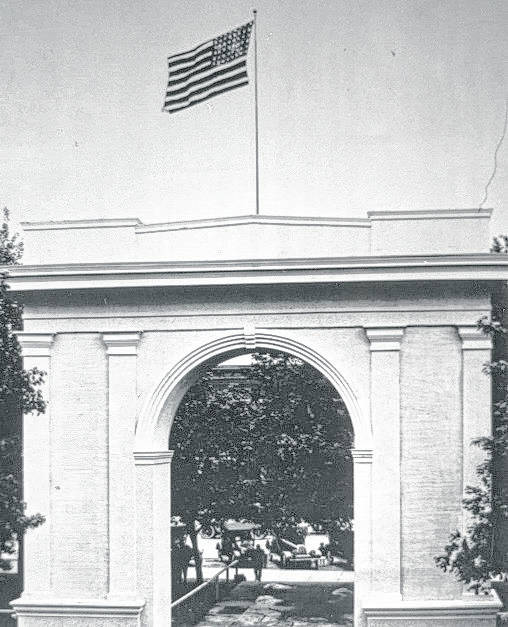

The United States entered the First World War in April 1917. For the next 20 months, more than 600 soldiers and sailors from Fayette County fought in the war or performed military duties that helped to achieve victory.
World War I began in Europe in the summer of 1914 and it soon became history’s first global conflict. By the time the war ended on Nov. 11, 1918, 41 men from Fayette County had died either in combat or from war-related wounds and disease.
On Tuesday, May 27, 1919, Fayette County honored its returning soldiers and sailors with an all-day homecoming and victory celebration in Washington Court House. The businesses and schools of the city and county closed for the occasion. Decorations in the national colors of red, white, and blue appeared everywhere. It was a bright, sunny day.
Money donated by Fayette County residents paid for the celebration. Mal Daugherty, president of the Midland National Bank, headed the 33-member main planning committee that orchestrated the activities of 200 other men and women who served on the subcommittees responsible for making the event a success.
The celebration included the dedication of a large memorial arch built over the sidewalk on the south side of the courthouse to honor the county’s sons who had died in the war. The arch was made of wood and it was covered with white stucco. The idea for the memorial arch originated with Jess Smith, an indefatigable civic booster, who owned a men, women, and children’s clothing store on North Main Street.
A ceremony to dedicate the arch began at mid-morning on the courthouse south lawn. Four hundred children from the city’s schools, dressed in red and white shirts, sat on a large speakers’ platform built over the courthouse steps. The youngsters sang several patriotic songs during the two-hour program.
James Douglass Post, a Washington C. H. attorney and a former member of the U. S. House of Representatives, presided over the dedication. He gave a brief address entitled “The People Back Home.” John G. Price, the Attorney General of Ohio and the featured speaker, recounted the contributions the men from Fayette County had made toward winning the war, which President Woodrow Wilson said would “make the world safe for democracy.”
The third speaker was Harry M. Daugherty, a Washington C. H. native who practiced law in Columbus. He was the absentee boss of Fayette County’s Republican Party. Daugherty paid tribute to all that “Old Fayette” had done on the home front to support the troops and wound up his remarks with a scathing denunciation of Bolshevik Russia. When the ceremony ended, an Army biplane flown by a pilot from McCook Field in Dayton performed a series of loops and nose dives over the downtown area.
At noon, the Fayette County Red Cross hosted a dinner for the veterans of all wars at the Knights of Pythias hall on North Fayette Street. There, the county’s finest cooks had prepared a scrumptious meal of chicken pie, new potatoes, relishes, bread, pie, and ice cream. A canteen on the courthouse north lawn dispensed complimentary sandwiches, coffee, soft drinks, and candy to the soldiers, sailors, and veterans in the afternoon.
The festivities continued in the afternoon with a parade that included 30 floats decorated with thousands of real and artificial flowers. Among the floats’ sponsors were the county’s fraternal orders, schools, and the Red Cross. Three bands played martial music. Soldiers and sailors from the Great War marched briskly. Veterans of the Civil War and the Spanish American War waved from automobiles to the crowds that lined the sidewalks.
Jess Smith, the parade’s organizer and its grand marshal, rode on a black horse at the head of the column. The portly Smith was no equestrian, but he gamely sat tall in the saddle as his steed pranced and whinnied along the city’s principal streets.
After dark, there were fireworks at Hagler’s Field at the southwest corner of Main Street and Circle Avenue. Planners advertised the pyrotechnics as “the most costly display of fireworks ever attended in this section of Ohio.” The day-long gala ended with an open air dance on the brightly illuminated block of Market Street between Fayette and Main streets. A 50-piece band provided music for the dancers until well after midnight.
This patriotic event from a century past is a reminder of Fayette County’s devotion to its sons who have fought and died in all of America’s wars. So too is the celebration a testimony to the boundless organizational talent and civic pride that was present in the county 100 years ago.
As for the memorial arch, it proved difficult to maintain. The arch became a roosting place for pigeons and a magnet for smoke and soot from the Paint Street railroad station. The arch was torn down in 1927 and was replaced in the same year with the veterans’ memorial monument that now stands on the south lawn of the courthouse.



